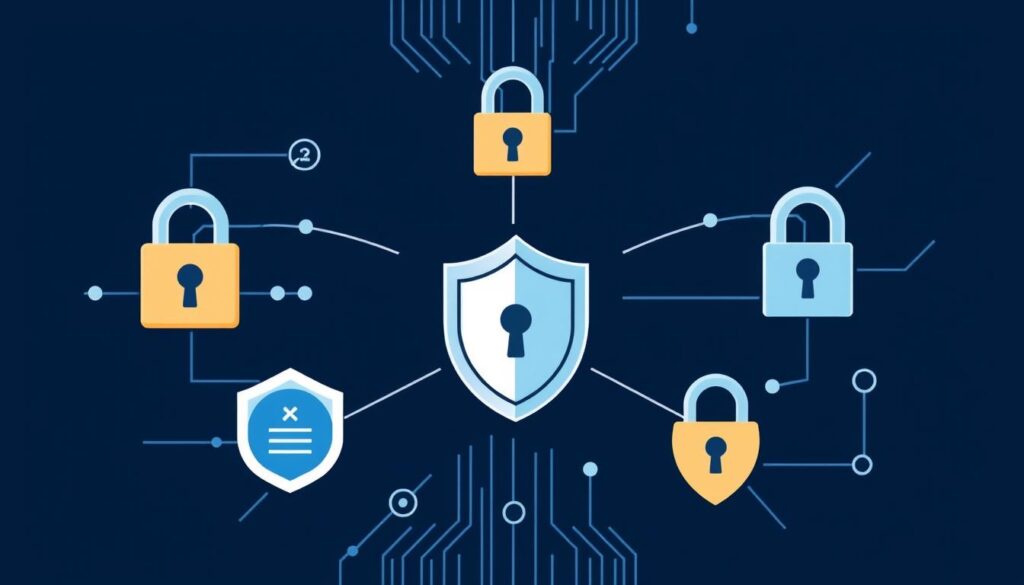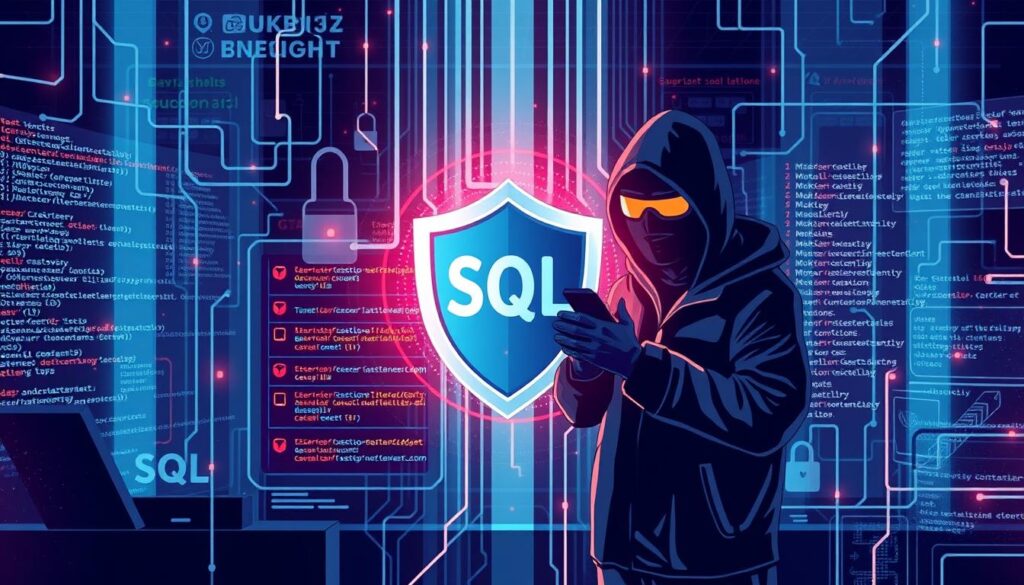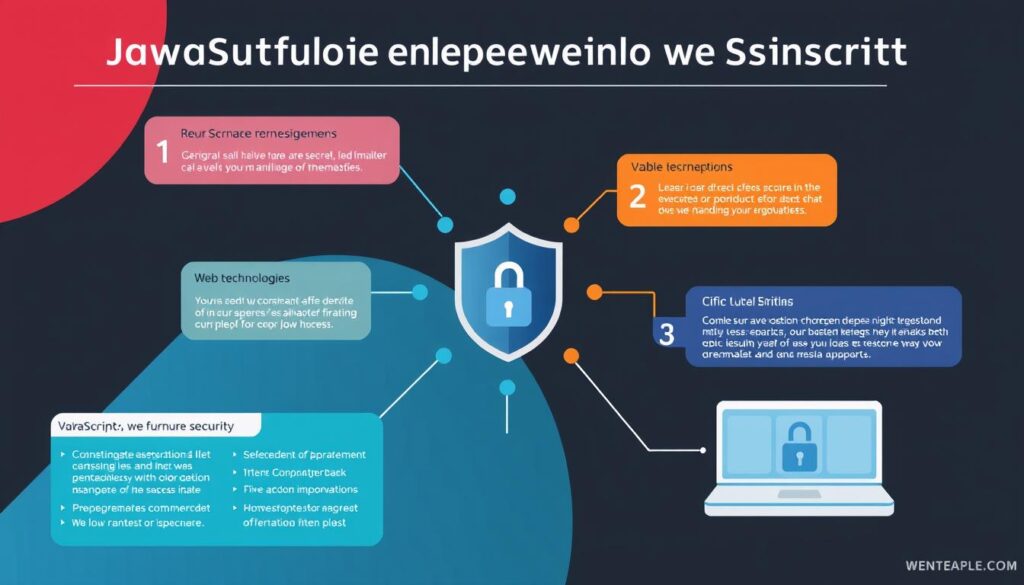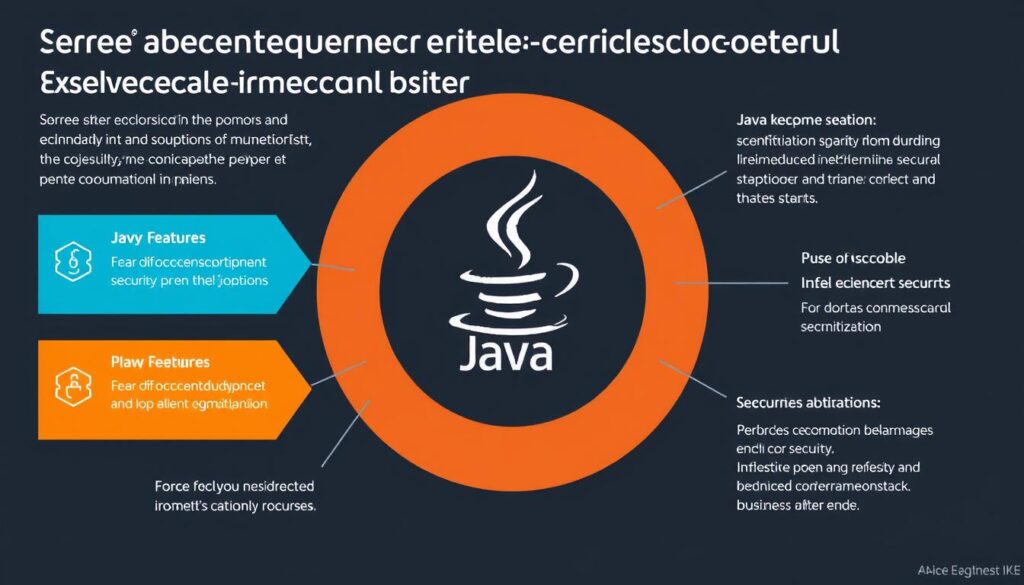In today’s rapidly evolving digital landscape, cybersecurity has become a critical concern for organizations worldwide. As threats become more sophisticated, the demand for skilled cybersecurity professionals who can protect systems and networks has skyrocketed.
You need programming skills to analyze malicious code, develop security tools, and respond efficiently to security incidents. Understanding various programming languages is essential for bridging the gap between security concepts and practical implementation.
This comprehensive guide will walk you through the most important programming languages that every cybersecurity professional should know in 2024.
Key Takeaways
- Mastering programming languages is crucial for cybersecurity professionals.
- Understanding various languages helps in analyzing malicious code and developing security tools.
- Cybersecurity professionals need to bridge the gap between security concepts and practical implementation.
- Knowing the right programming languages can enhance your cybersecurity career.
- Cybersecurity requires a combination of skills, including programming and security knowledge.
The Role of Programming in Modern Cybersecurity
As cybersecurity threats continue to evolve, the role of programming in developing effective security measures cannot be overstated. In today’s digital landscape, understanding programming concepts is crucial for cybersecurity professionals to correctly interpret the activity of malicious actors on their networks.
Cybersecurity professionals must be able to write code to perform their work more efficiently and effectively. While not every cybersecurity job explicitly includes coding skills as a job requirement, having the ability to write code can significantly enhance a professional’s capabilities in the field.
Why Coding Skills Are Essential for Security Professionals
Coding skills are essential for security professionals because they enable the creation of custom security tools tailored to an organization’s specific needs. With coding skills, professionals can automate the correlation of security data from multiple sources, helping identify patterns and potential threats that might otherwise go unnoticed.
How Programming Enhances Cybersecurity Capabilities
Programming enhances cybersecurity capabilities in several key ways:
- Creating custom security tools to address specific organizational needs
- Automating security data correlation to identify potential threats
- Performing thorough security assessments by evaluating code-level vulnerabilities
- Enhancing incident response capabilities through quick script development
- Bridging the gap between security requirements and practical implementation in the development lifecycle through DevSecOps practices
Important Programming Languages for Cybersecurity Professionals

Mastering specific programming languages is essential for a successful cybersecurity career. The choice of language may vary depending on your specific role, projects, and the technologies you encounter.
How Programming Languages Support Different Security Functions
Different programming languages support various security functions. For instance, security analysts often focus on Python and PowerShell, while security engineers may need C/C++ and Java.
- Python is versatile and used for various security tasks.
- PowerShell is crucial for Windows environment security.
- C/C++ provides low-level memory management for security-critical applications.
- Java is used in enterprise security development.
Selecting the Right Language for Your Cybersecurity Career Path
To choose the right language for your cybersecurity career, consider your career path and the technologies you’ll be securing. Industry job postings can provide valuable guidance on in-demand languages.
- Identify your career goals and the required skills.
- Focus on becoming proficient in one or two core languages.
- Develop working knowledge of other languages as needed.
Python: The Swiss Army Knife for Cybersecurity

As a cybersecurity professional, you’re likely to encounter Python in various security tasks. Python’s simplicity, flexibility, and extensive libraries make it an ideal language for a wide range of cybersecurity applications.
Why Python Dominates the Cybersecurity Landscape
Python’s dominance in cybersecurity can be attributed to its ease of use and the extensive range of libraries available. It allows professionals to quickly develop and deploy security tools and scripts, making it a favorite among both blue and red teams.
Essential Python Libraries for Security Tasks
Python’s libraries are a key factor in its success within the cybersecurity community. Libraries such as Scapy and Metasploit provide comprehensive network and security functionalities. These libraries enable professionals to perform complex tasks with ease, from network scanning to exploit development.
Some of the key libraries include:
- Scapy for packet manipulation and network exploration
- Metasploit for developing and executing exploits
- Nmap for network scanning and discovery
Real-World Applications in Blue Team and Red Team Operations
Python is utilized differently by blue and red teams, but its versatility makes it invaluable to both. Blue teams use Python to automate tasks such as log analysis, vulnerability scanning, and compliance checking. Red teams, on the other hand, leverage Python to develop custom scripts and tools for penetration testing and exploit development.
Some practical applications include:
- Developing custom SIEM integrations and security dashboards
- Automating routine security tasks like vulnerability scanning
- Creating specialized tools for reconnaissance
PowerShell: Essential for Windows Security

In the realm of Windows security, PowerShell stands out as a versatile and powerful scripting language. Its deep integration with the Windows operating system makes it an essential tool for cybersecurity professionals.
PowerShell’s Role in Windows Environment Security
PowerShell provides robust capabilities for managing and securing Windows environments. Its scripting abilities allow for the automation of various security tasks, enhancing the overall security posture of Windows systems.
Automating Security Tasks with PowerShell
Automation is key to efficient security management, and PowerShell excels in this area. By automating routine security tasks, you can reduce the risk of human error and ensure consistent application of security policies across your Windows systems.
PowerShell for Offensive and Defensive Operations
PowerShell is utilized in both offensive and defensive cybersecurity operations. On the defensive side, it offers features like Just Enough Administration (JEA) and robust logging capabilities to detect and investigate suspicious activities. Offensively, PowerShell’s scripting capabilities are used for Active Directory enumeration and attacks, making it a valuable tool for red teams and ethical hackers.
Understanding PowerShell’s dual role in cybersecurity helps professionals develop better security measures. By leveraging PowerShell’s capabilities, you can enhance your Windows security, automate tasks, and improve your overall security posture.
Bash and Shell Scripting: Command Line Power

Mastering Bash scripting can significantly enhance your security capabilities. As a security professional, you can leverage Bash’s command-line interface and powerful tools like grep and awk to effectively manipulate and process large datasets.
This capability enables you to create custom tools for log analysis, data extraction, and parsing, allowing for deeper insights into potential threats. By automating routine tasks, you can focus on more complex security challenges.
Leveraging Bash for System Security and Automation
Bash scripting is instrumental in automating security tasks and enhancing system security. You can create scripts to automate security audits by checking for misconfigurations, weak permissions, or unauthorized changes to critical system files.
For instance, a Bash script can monitor authentication logs for failed login attempts, alerting you when potential brute force attacks are detected. This proactive approach helps in identifying and mitigating threats before they escalate.
Practical Shell Scripting Examples for Security Tasks
Several practical examples illustrate the power of Bash scripting in security tasks. You can:
- Automate the collection of forensic data during incident response, gathering system information, running processes, network connections, and other relevant artifacts.
- Create custom port scanning tools using Bash when standard tools aren’t available.
- Implement file integrity monitoring by regularly calculating and comparing cryptographic hashes of critical system files to detect unauthorized modifications.
By incorporating Bash scripting into your security toolkit, you can significantly enhance your capabilities in automation, security, and scripting, making you more effective in your role.
SQL: Securing and Exploiting Databases

Understanding SQL is crucial for anyone in cybersecurity, as it provides the means to secure, manage, and analyze database systems. Proficiency in SQL is vital for success in both blue and red team scenarios, allowing professionals to navigate and manipulate databases to achieve their objectives.
Understanding SQL for Database Security
SQL, or Structured Query Language, is the standard language for managing relational databases. Knowing SQL enables you to understand how databases are structured and how data is stored and retrieved. This knowledge is fundamental for identifying potential security vulnerabilities and implementing measures to protect against them.
You can use SQL to manage user privileges, ensuring that access to sensitive data is restricted to authorized personnel. By understanding SQL, you can also implement robust security measures such as encryption and secure data storage practices.
Identifying and Preventing SQL Injection Attacks
One of the most significant threats to database security is SQL injection, a technique used by attackers to inject malicious SQL code into web applications’ database queries. Understanding SQL helps you identify vulnerabilities that could be exploited through SQL injection attacks.
To prevent SQL injection, you can use prepared statements with parameterized queries, limit database privileges to the minimum required, and regularly update and patch your database management systems.
Using SQL for Security Analysis and Forensics
SQL skills are invaluable during security incidents, as they enable you to perform forensic analysis on database logs and content. This analysis helps determine what data may have been accessed or modified by attackers.
- During security incidents, SQL skills enable you to perform forensic analysis on database logs and content to determine what data may have been accessed or modified by attackers.
- You can use SQL to correlate events across multiple database tables and systems, helping to establish timelines and understand the full scope of security incidents.
- For compliance purposes, SQL allows you to efficiently query and report on sensitive data locations, access patterns, and protection measures across your database environment.
- Security monitoring systems often store their data in SQL databases, making SQL proficiency essential for creating custom security reports and dashboards.
- In database security assessments, your SQL skills help you identify excessive privileges, weak configurations, and other security issues that might not be detected by automated scanning tools.
JavaScript: Web Security Essentials

In the realm of web security, JavaScript is a double-edged sword that requires a deep understanding to wield effectively. As a key technology behind web applications, JavaScript’s impact on security is multifaceted. On one hand, it’s used to create interactive and dynamic user experiences. On the other hand, it can be exploited by attackers to execute malicious code.
Role in Web Application Security
JavaScript frameworks like Node.js facilitate server-side scripting, enabling security professionals to develop tools for vulnerability scanning and data analysis. Understanding JavaScript execution contexts is crucial for identifying DOM-based vulnerabilities where client-side code manipulates data insecurely. Moreover, knowledge of JavaScript helps in recognizing and preventing client-side security bypasses.
For security testing, JavaScript can be leveraged to develop custom tools that interact with web applications, test for vulnerabilities, and automate security assessments. This proactive approach enhances the security posture of web applications.
Identifying and Mitigating JavaScript-Based Attacks
Cross-Site Scripting (XSS) remains a prevalent threat, allowing attackers to inject malicious JavaScript that executes in users’ browsers. To mitigate such attacks, understanding how JavaScript code can be manipulated is essential. Server-side JavaScript environments like Node.js present unique security challenges, including prototype pollution and insecure dependency management, which security professionals must be equipped to identify and address.
By grasping the fundamentals of JavaScript security, professionals can better protect web applications from various threats and enhance overall web security.
C and C++: Low-Level Security Programming

For those in the cybersecurity field, understanding C and C++ is crucial for various security tasks. Many security tools and frameworks, such as Wireshark and Metasploit, are written in C/C++, emphasizing their significance in the field.
C/C++ knowledge is essential for several security applications, including reverse engineering binary applications and exploit development. With C/C++, you can understand disassembled code and identify vulnerabilities in closed-source software.
Understanding Memory Management for Security
Memory management is a critical aspect of C/C++ programming that directly impacts security. Understanding how to manage memory effectively helps prevent common vulnerabilities such as buffer overflows.
By mastering memory management, you can develop more secure applications and identify potential security risks in existing code.
Applications in Reverse Engineering and Exploit Development
C/C++ is vital for reverse engineering and exploit development. With C/C++, you can craft reliable exploits by manipulating memory precisely to achieve code execution or bypass security controls.
Security researchers use C/C++ to develop proof-of-concept exploits that demonstrate the impact of vulnerabilities in a controlled manner. Additionally, C/C++ knowledge helps you understand the techniques used by sophisticated malware threats.
For developing security tools that interact directly with hardware or require maximum performance, such as network sniffers or encryption tools, C/C++ remain the languages of choice.
Java: Enterprise Security Development

In the realm of enterprise security, Java stands out as a versatile and widely adopted programming language. Its popularity in enterprise environments also means a wealth of security libraries and frameworks that can be utilized to develop secure applications and implement cryptographic algorithms.
Java’s Security Features and Applications
Java offers several security features that make it an ideal choice for enterprise security development. You can leverage frameworks like Spring Security that provide comprehensive authentication, authorization, and protection against common web vulnerabilities. Additionally, Java’s robust implementations of TLS/SSL through the JSSE (Java Secure Socket Extension) framework ensure secure communications.
Understanding Java helps you implement proper input validation, output encoding, and other security controls to prevent injection attacks and cross-site scripting in web applications. Moreover, knowledge of Java enables you to perform more effective code reviews of enterprise applications, identifying security flaws in authentication, access control, and data protection implementations.
Building Secure Applications with Java
When developing secure Java applications, it’s crucial to be aware of the potential security challenges. For instance, Java’s serialization mechanism presents unique security risks that you should understand to prevent deserialization attacks that can lead to remote code execution. By being mindful of these risks and utilizing Java’s security features, you can build robust and secure enterprise applications.
Some key practices include using frameworks that provide security out of the box, implementing secure coding practices, and staying updated with the latest security patches and updates for Java.
Ruby: Penetration Testing and Automation

When it comes to penetration testing and automation, Ruby stands out as a valuable tool due to its elegant syntax and focus on productivity. You can leverage Ruby’s concise syntax and powerful string manipulation capabilities to develop tools that parse and analyze security data from various sources.
Ruby’s Role in Security Testing Frameworks
Ruby plays a significant role in security testing frameworks, thanks to its metaprogramming features that allow you to create flexible security tools. These tools can adapt to different target environments or security testing scenarios, making Ruby a versatile language for security professionals.
Using Ruby for Custom Security Tools
You can use Ruby to develop custom security tools for specific tasks, such as web application security testing. Ruby’s HTTP libraries and JSON parsing capabilities enable you to create tools for API security assessment. Additionally, Ruby’s integration with command-line tools makes it useful for automating tasks and creating wrappers around existing security utilities.
Go (Golang): Modern Security Applications

The Go programming language is gaining traction in cybersecurity for its simplicity, concurrency support, and robust security features. Its built-in support for concurrency and networking, along with its strong focus on security and error handling, make it ideal for developing secure network applications and services.
Go’s Strengths for Security Tool Development
Go’s performance approaches that of C/C++ while offering memory safety and garbage collection, making it ideal for security applications that process large volumes of data. The language’s efficient concurrency model allows you to develop security tools that can handle thousands of simultaneous connections with minimal resource usage.
Performance Benefits for Security Applications
For network security tools, Go’s built-in networking libraries and efficient I/O operations provide excellent performance for tasks like packet capture, protocol analysis, and network scanning. You can leverage the growing ecosystem of security-focused Go libraries, including tools for vulnerability scanning, cryptography, and secure communications, to enhance your security applications. For more information on using Go for security, check out Security with Go.
Rust: Memory-Safe Security Programming

The Rust programming language is emerging as a critical tool in the cybersecurity arsenal, offering a compelling blend of safety and speed. As you explore the landscape of programming languages for cybersecurity, Rust’s unique features make it an attractive choice for developing secure applications.
Safety Features for Secure Development
Rust’s ownership and borrowing system are key to its security benefits, helping prevent common vulnerabilities like buffer overflows and null pointer dereferences. This system ensures that memory is managed safely and efficiently, reducing the risk of security breaches.
By leveraging Rust’s safety features, you can develop applications with a lower risk of memory-related security issues, making it an ideal choice for security-critical components.
Applications in System Security and Cryptography
Rust is increasingly used for developing security-critical components like cryptographic libraries, secure networking stacks, and system utilities where memory safety is paramount. Its performance characteristics also make it suitable for security applications that need to process large volumes of data efficiently.
- Rust is used in developing cryptographic libraries and secure networking stacks.
- It provides safe abstractions for working with unsafe code, allowing interface with existing C libraries or system calls while maintaining safety.
- Security tools written in Rust tend to be more resistant to exploitation themselves.
- Projects like RustCrypto provide memory-safe implementations of cryptographic algorithms.
Learning Strategies for Cybersecurity Professionals

To stay ahead in the cybersecurity landscape, it’s essential to develop a strong foundation in programming languages. As a cybersecurity professional, your ability to learn and adapt to new programming skills can significantly impact your career advancement. Effective learning strategies are crucial for mastering the programming skills required in this field.
When starting out, it’s vital to choose the right programming language to learn first. With numerous languages being used in cybersecurity, selecting one that aligns with your career goals is important.
Choosing Your First Programming Language
Selecting your first programming language can be daunting, given the numerous options available. However, languages like Python are highly recommended for beginners due to their simplicity and versatility in cybersecurity applications. Consider your career aspirations and the type of security work you’re interested in when making your decision.
For instance, if you’re interested in web security, learning JavaScript might be beneficial. On the other hand, if you’re more inclined towards system administration and automation, Bash or PowerShell could be a good starting point.
Effective Learning Resources and Approaches
Once you’ve chosen a programming language, the next step is to find effective learning resources. Hands-on learning platforms such as Hack The Box and TryHackMe provide practical experience by allowing you to apply programming skills to real-world cybersecurity challenges.
- Interactive coding platforms like Codecademy and HackerRank offer structured learning paths with immediate feedback.
- Specialized courses from platforms like SANS and Offensive Security incorporate programming within their security training.
- Reading and modifying open-source security tools can help you understand both programming techniques and security concepts.
Developing a learning routine that combines structured learning with practical application is key to reinforcing your programming skills. By dedicating time to both learning and applying your knowledge, you can significantly enhance your capabilities as a cybersecurity professional.
Conclusion: Building Your Programming Toolkit for Cybersecurity Success
In the dynamic field of cybersecurity, having a strong grasp of various programming languages is crucial for success. As a cybersecurity professional, your ability to analyze threats, develop security tools, and automate tasks is significantly enhanced by your programming skills.
Focus on building proficiency in a core set of languages that align with your career path and interests. The languages explored, including Python, PowerShell, and SQL, each serve different security functions and can be applied to various cybersecurity challenges. By developing a robust toolkit of programming skills, you’ll be better equipped to adapt to new threats and technologies, ultimately advancing your career in this ever-evolving field.
FAQ
What programming language is most commonly used in cybersecurity?
Python is widely regarded as the most versatile and widely used language in cybersecurity due to its simplicity and extensive libraries, making it ideal for tasks ranging from penetration testing to security research.
How does SQL knowledge benefit a cybersecurity professional?
Understanding SQL is crucial for managing and securing databases. It helps in identifying vulnerabilities such as SQL injection attacks, which can compromise database security, and enables professionals to implement measures to prevent such threats.
Can PowerShell be used for both defensive and offensive cybersecurity operations?
Yes, PowerShell is a powerful tool that can be used for both defensive and offensive operations. It’s used for automating security tasks, managing Windows environments, and can also be utilized by attackers for malicious purposes, making it a critical skill for cybersecurity professionals to understand.
Why is JavaScript important for web application security?
JavaScript plays a significant role in web application security as it’s a primary language used for client-side scripting. Understanding JavaScript helps in identifying and mitigating client-side vulnerabilities and attacks, such as cross-site scripting (XSS).
What are the benefits of using Rust for security programming?
Rust offers memory safety features that are crucial for developing secure applications. Its focus on safety and performance makes it an attractive choice for system security and cryptography applications where security is paramount.
How can learning multiple programming languages enhance a cybersecurity career?
Learning multiple programming languages broadens your skill set, allowing you to tackle a variety of security tasks and understand different systems and applications. This versatility is highly valued in the cybersecurity field, making you a more effective and adaptable professional.
Is it necessary to know C and C++ for a career in cybersecurity?
Knowledge of C and C++ can be beneficial for understanding low-level system operations and memory management, which is crucial for certain areas of cybersecurity, such as reverse engineering and exploit development.
